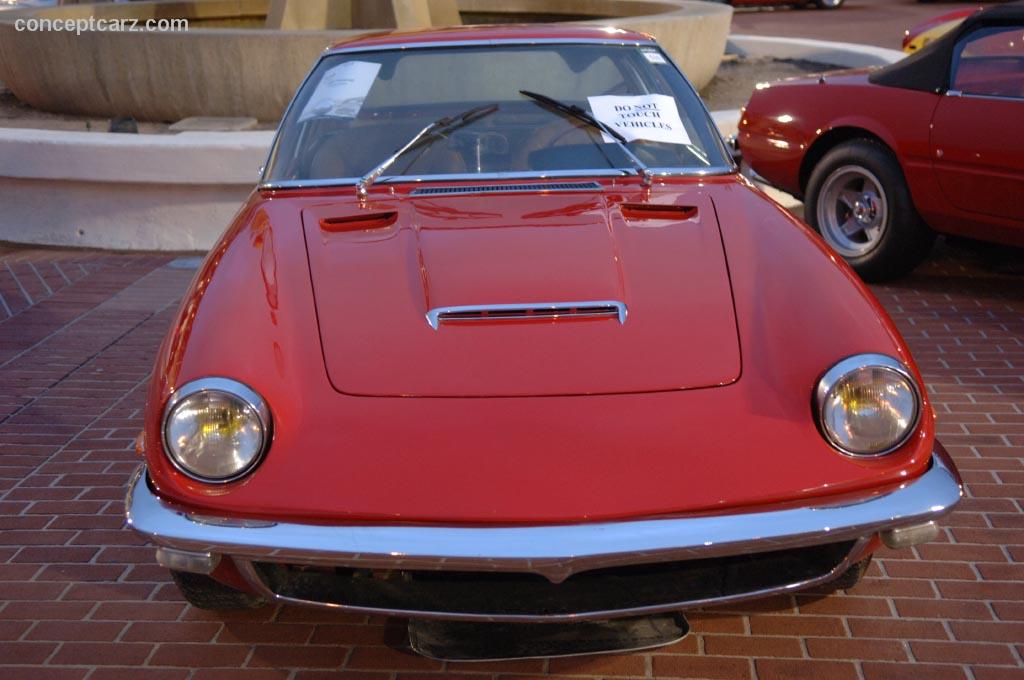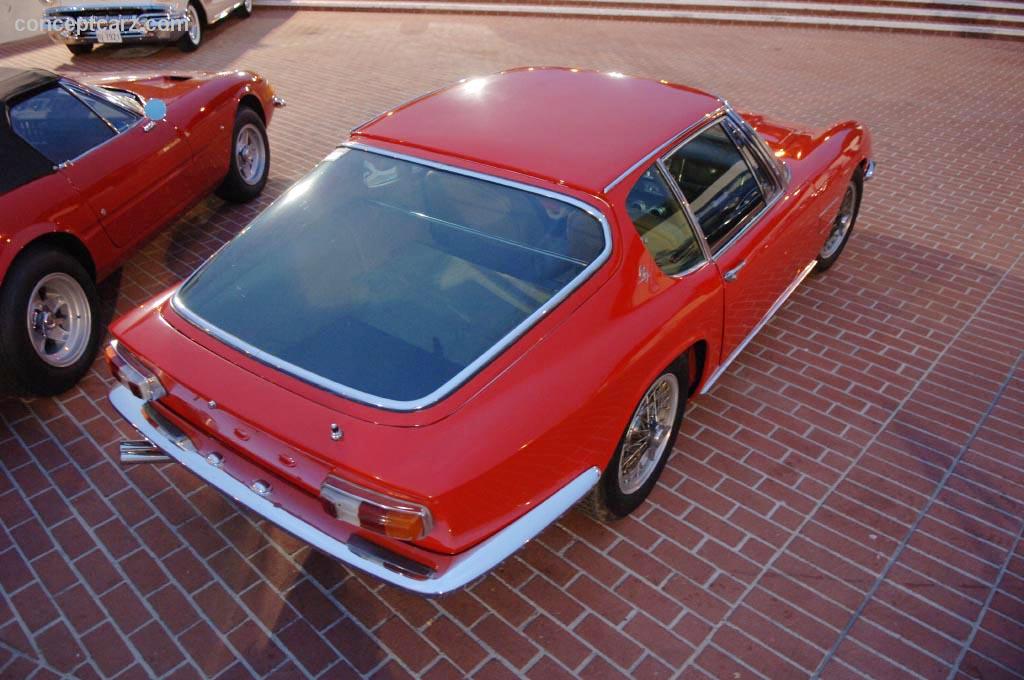Maserati turned its attention away from Grand Prix and sports car racing activities in the late 1950s, focusing instead on road-car production. This was a survival strategy intended to re-establish its financial footing and ensure its longevity. Up to this point, Maserati was still producing cars on a small scale, with its high-performance sports cars intended for wealthy clientele. Maserati's new era began in 1957 with the introduction of the Touring-bodied 3500 GT at the Geneva Salon. The new '2+2' was built using the lessons learned at the track, employing a tubular chassis frame and an engine derived from the 350S sports car. It was a twin-overhead-camshaft, six-cylinder unit that was a close relative of the engine powering the World Championship-winning 250F. The suspension used a conventional live axle and semi-elliptic setup at the rear, while the run was independent by wishbones and coil springs. Drum brakes and a four-speed transmission were used initially, later giving way to a five-speed unit, front disc brakes, and, eventually, all-disc braking. Developed by engineer Giulio Alfieri, the 3500 GT became the company's first attempt at series production, and it was their first attempt at the Gran Turismo market. Maserati's Grand Prix-winning six-cylinder engine would power several of its road-going models, with the final being the Pietro Frua-styled Mistral. Most examples received the 3.7-liter version of the long-stroke engine, while a more potent 265-horsepower 4.0-liter version was installed in later Mistrals. Subsequent models to the Mistral were equipped with V8 engines as the company sought to remain competitive in an industry where rivals were increasingly offering more powerful vehicles.The Maserati Mistra
The Mistral (Tipo AM109) was named after the cold northerly wind of southern France, and was the first Maserati model to be named after a wind. This 2-seat gran turismo was the successor to the 3500 GT, and was built on a shortened version of the square tube chassis also used by the Sebring and 3500GT. Body styles included a coupe and open spyder, with the former's opening rear window hatch adding to its practicality as a sporting GT car. Standard equipment included disc brakes and a five-speed gearbox, while air conditioning, a limited-slip differential, and an automatic transmission were optional.
Coupe
Chassis #: AM 109306
View info and history
Auction entries : 1By the time production ceased in 1970, a total of 124 Spiders and 827 coupes had been built. The Mistral's successor was the Ghibli which was first unveiled as a 2-seater concept car at the Turin Motor Show in November 1966. Styled by Giorgetto Giugiaro at Ghia, the Ghibli remained in production through 1973, producing a total of 1,170 coupes and 125 Spyders. The Ghibli was succeeded the following year by the Bertone-designed Khamsin. Specifications
Dimensions
The Maserati Mistral rested on a 94.5-inch wheelbase platform with an overall length of 177.2 inches, a height of 51.2 inches, and a width of 65.9 inches. It weighs approximately 3,150 lbs (1,430 kg). The Mistral was smaller than its predecessor, the 3500 GT, which had a 102.4-inch wheelbase for its coupe and 98.4 inches for its spyder. The 3500GT Coupe was eleven inches longer and 3.4 inches wider than the Mistral.
Coupe
Chassis #: AM 109306
View info and history
Auction entries : 1Engine
Initially, the Mistral was powered by a 3.5-liter (3,485.29cc) version of the inline-6-cylinder engine. It had hemispherical combustion chambers, a Lucas indirect fuel injection system, dual overhead camshafts, dual ignition, an aluminum block, aluminum cylinder heads, cast iron cylinder sleeves, and produced 235 horsepower at 5,500 RPM. Its bore measured 3.4 inches, and its stroke at 3.9 inches. Only the Spyder received the 3.5-liter (3500) engine and just twelve examples were built. Seventy-six examples of the Mistral were equipped with the 3.7-liter engine, which produced 245 horsepower at 5,500 RPM. Thirty-seven examples were given the ultimate iteration of this engine, the 4.0-liter version that produced 265 bhp at 5,200 RPM. Chassis
The tubular platform chassis had an independent suspension setup at the front and a solid axle at the rear. Four-wheel solid disc brakes, a five-speed ZF transmission, and Pirelli Cinturato 185VR16 CA67 tires were standard equipment. Later examples received Borrani wire wheels wrapped with 205VR15 tires.Body
The body was penned by Pietro Frua and represented a new styling direction for the company. A few examples were steel-bodied while others had a combination f steel with aluminum doors and hoods; other examples were all aluminum. The Mistral was one of the first cars to have a hatchback.
by Daniel Vaughan | Sep 2024
The Mistral (Tipo AM109) was named after the cold northerly wind of southern France, and was the first Maserati model to be named after a wind. This 2-seat gran turismo was the successor to the 3500 GT, and was built on a shortened version of the square tube chassis also used by the Sebring and 3500GT. Body styles included a coupe and open spyder, with the former's opening rear window hatch adding to its practicality as a sporting GT car. Standard equipment included disc brakes and a five-speed gearbox, while air conditioning, a limited-slip differential, and an automatic transmission were optional.

Coupe
Chassis #: AM 109306
View info and history
Auction entries : 1
Dimensions
The Maserati Mistral rested on a 94.5-inch wheelbase platform with an overall length of 177.2 inches, a height of 51.2 inches, and a width of 65.9 inches. It weighs approximately 3,150 lbs (1,430 kg). The Mistral was smaller than its predecessor, the 3500 GT, which had a 102.4-inch wheelbase for its coupe and 98.4 inches for its spyder. The 3500GT Coupe was eleven inches longer and 3.4 inches wider than the Mistral.

Coupe
Chassis #: AM 109306
View info and history
Auction entries : 1
Initially, the Mistral was powered by a 3.5-liter (3,485.29cc) version of the inline-6-cylinder engine. It had hemispherical combustion chambers, a Lucas indirect fuel injection system, dual overhead camshafts, dual ignition, an aluminum block, aluminum cylinder heads, cast iron cylinder sleeves, and produced 235 horsepower at 5,500 RPM. Its bore measured 3.4 inches, and its stroke at 3.9 inches. Only the Spyder received the 3.5-liter (3500) engine and just twelve examples were built. Seventy-six examples of the Mistral were equipped with the 3.7-liter engine, which produced 245 horsepower at 5,500 RPM. Thirty-seven examples were given the ultimate iteration of this engine, the 4.0-liter version that produced 265 bhp at 5,200 RPM. Chassis
The tubular platform chassis had an independent suspension setup at the front and a solid axle at the rear. Four-wheel solid disc brakes, a five-speed ZF transmission, and Pirelli Cinturato 185VR16 CA67 tires were standard equipment. Later examples received Borrani wire wheels wrapped with 205VR15 tires.Body
The body was penned by Pietro Frua and represented a new styling direction for the company. A few examples were steel-bodied while others had a combination f steel with aluminum doors and hoods; other examples were all aluminum. The Mistral was one of the first cars to have a hatchback.
by Daniel Vaughan | Sep 2024
Related Reading : Maserati Mistral History
The Mistral was produced from 1963 through 1970. During its production lifespan, 120 spyders and 830 coupes were produced. The design had been penned by the Italian stylist Pietro Frua, arguably one of his greatest automotive designs. The French had a name for a strong, cold wind in their southern region, it was Mistral. Maserati adopted the name because it embodied the essence of the wind - speed.....
Continue Reading >>
Continue Reading >>
Similar Vehicles
Similar Automakers
Similarly Sized Vehicles
from 1968
1968 Maserati Mistral Vehicle Profiles
Recent Vehicle Additions
Performance and Specification Comparison
Price Comparison
$12,800
$15,300 - $16,300
$166,900
Mistral Specification Comparison by Year
Year
Production
Wheelbase
Engine
Prices
Related Automotive News

F1 Champion Jenson Button's Porsche 964 Turbo X88 Sells For $439,099 on Collecting Cars Auction Platform
Specially Commissioned By Sultan of Brunei, Unique 964-Generation 911 Turbo Offered On Behalf of 2009 Formula One World Champion
A 1994 Porsche 911 (964) Turbo 3.6 X88 owned and driven by 2009 Formula One World Champion Jenson Button has sold...

Gooding & Company Unveils Online Catalogue for Pebble Beach Auctions, Announces Additional Star Consignments
The catalogue features major new additions from the auction house, including a 1959 Ferrari 250 GT LWB California Spider Competizione, a 1998 Mercedes-Benz AMG CLK GTR Strassenversion, a 1957 Maserati 200 SI, and a 1961 Aston Martin DB4 GT.
The...

FIRST-EVER SPORTS CAR AMONG EXTRAORDINARY LINE UP FOR BONHAMS' BOND STREET SALE
The worlds first sports car – the Prince Henry Vauxhall leads Bonhams Bond St Sale
The original supercar – the iconic 1957 Mercedes-Benz 300 SL Roadster
James Bond Aston Martin DB5 with two-owner faultless records
One of the first Maserat...

Fabulously Presented 1971 Maserati Ghibli Joins the Ever Growing Line Up of Incredible Offerings at Russo and Steele's 3rd Annual Newport Beach Collector Automobile Auction
Scottsdale, Arizona (May 12, 2015) – Launched at Turin in 1966, Maseratis Ghibli was appropriately named after the hot, dust-blowing wind currents of North Africa and featured handsomely tailored bodylines penned by a brilliant young Giorgetto...

Advanced 2.7-Liter EcoBoost with Auto Start-Stop Brings New Capability and Efficiency to Next Ford F-150
Latest EcoBoost® technology in an all-new, even more efficient 2.7-liter engine that features extremely high output and lightweight design coupled with standard Auto Start-Stop optimized for trucks
Delivers the performance of a mid-range V8 w...

































